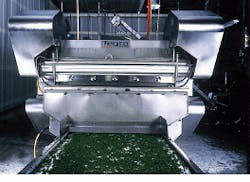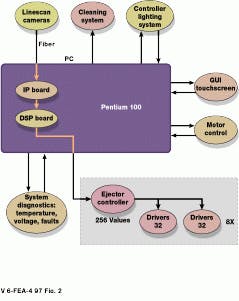MACHINE VISION SPEEDS food processing AND HIGH-SPEED SORTING
MACHINE VISION SPEEDS food processing AND HIGH-SPEED SORTING
By John Haystead, Contributing Editor
The National Frozen Foods (Burlington, WA) vegetable-processing plant handles 55 million-65 million pounds of vegetables per year, including 20 million-25 million pounds of peas. Until last year, manual labor was used to inspect and sort vegetables. Now, with the installation of a machine-vision inspection and sorting system from Key Technology (Walla Walla, WA), National has reduced manual inspection costs and improved production of its high-grade vegetables.
While using automated inspection equipment can benefit any company`s bottom line, the stringent quality and cost controls required in the food-processing industry are making automation more a requirement than an option. "To produce higher-grade vegetables requires capable and efficient inspection and sorting systems," says Gary Ash, National`s manager of operations and production.
Although the Tegra system from Key Technology sorts other products by size and shape, it sorts peas solely by color because they are generally of consistent size. They are also graded and separated according to specific gravity prior to inspection (see "Grooming peas for visual inspection").
National evaluated a number of systems and technologies, ultimately selecting the linescan-camera-based Tegra system. Although cost and ease of use were important, the determining factor in National`s decision was system performance. "Other color sorters had relatively high good-to-bad sorting ratios. They removed three to four good peas along with every bad one. In contrast, the Tegra system produces a 1.5-2:1 ratio that is equal to or better than manual sorting," says Ash.
In the Tegra system, images of vegetables are first captured by RGB linescan cameras. Depending on whether it is a full-wide (60 in.) or half-wide machine, the system is equipped with either two or four cameras, positioned above and below the product. Cameras are oriented in a tilted-X configuration, and vegetables are imaged as they drop past a 1-in. gap in the conveyer (see Fig. 1). This allows the overhead camera to view the leading edge of the product while the lower camera simultaneously views its trailing edge.
Although the linescan sensors generate 2048 pixels, a series of internal windowing and filtering functions reduces this to 1024 pixels for later image processing. Analog-to-digital converters digitize each pixel to 10 bits per red-green-blue (RGB ) channel at 5 MHz. Digital data are then transmitted via a 200-Mbit/s fiberoptic data link to an image processor. A separate RS-422 interface provides camera control, synchronization, and configuration signals.
RGB signals feed into a central EISA-bus Pentium PC-based processing unit that houses four separate image-processing boards, one for each camera. Although the EISA bus provides power and hosts the user interface, all real-time processing and data-transfer functions are handled via interprocessor communication links and ports (see Fig. 2).
The image-processing boards demultiplex serial fiberoptic data and perform normalization, color segmentation, filtering, and object feature extraction. On each board, a pipeline of 11 Altera (San Jose, CA) EPLDs and four Xilinx (San Jose, CA) field-programmable gate arrays are used for control timing and object recognition and filtering.
Normalization and color feature extraction are performed using on-board look-up tables that compare captured images to known color combinations. In this way, product feature and defect data can be determined. For size and shape extraction, morphological or structure-based processing measures the extent to which a structuring element matches the image data. "Such techniques are useful for edge detection, skeletonization, shape analysis, feature generation, general thinning, compression, and filtering," says David Seymour, Key Technology`s principal electronics engineer.
Object-based algorithms
After initial image processing, image data are passed to one of two Texas Instruments (Stafford, TX) TMSC40 DSP processor boards. Each C40 handles data from a specific image processor that are transferred using the C40`s processor-to-processor commun ication ports. Because object recognition is performed in hardware on the image-processing boards, the DSPs are used to run object-based sorting algorithms that ensure that defective products are removed from the process line.
Algorithm complexity varies according to product type and the sophistication of the sorting criteria. While peas can be sorted based on only color-defect recognition, cut green beans require sophisticated ob ject -feature shape extraction algorithms because defects, such as ends or stems, will be the same color as the rest of the bean. However, although the Tegra system was only programmed to sort by color, its filtering features can be used to automatically identify and remove stem fragments, skins, or split peas.
Because defective product can be located anywhere on the 60-in.-wide conveyer traveling at 590 ft/min, and the line-of-sight cameras are positioned 3--5 in. from the ejector mechanism, image acquisition, recognition, processing, and decision process must occur rapidly. "Although we looked at off-the-shelf image processing products, we could not achieve the level of functionality or speed required. Indeed, the vast majority of off-the-shelf components are designed to operate at 30 frames/s and could not match the speed requirements of the Tegra system," says Richard Stroman, Key Technology`s director of development engineering.
The ejector mechanism comprises 256 air valves or puffers coupled to nozzels at approximately 0.25-in. spacing. The rejection procedure is different for each product. With green beans, the system first determines how each individual defective bean is oriented on the conveyer and will instruct which, when, and in what sequence to fire the puffers to remove the product. The timing of the blasts is calculated from both the location of the product as it passes the imager and the speed of the belt.
Setup and control
National`s plant personnel configure the Tegra system for different products and sorting parameters using a touch-screen display and KeyWare graphical-user-interface (GUI) application packages running under Windows NT (see Fig. 3). The GUI decouples user control and application programming from the system`s hardware architecture and C-based DSP software. "Changing products just requires loading a particular software package," says Ash.
Although KeyWare packages are tailored for specific products, users can select individual quality-control thresholds or define specific product-rejection parameters. To train the system for a particular process or product, the PC captures and transfers 1024 ¥ 512 images from the image-processor board to its main memory and display. Operators then use a split-screen function to zoom on specific areas and enlarge objects to select individual groups of pixels representing good or defective product areas.
Although National still performs manual inspection after automated sorting, the Tegra system has reduced the overall workload. Even with the dual-inspection process, National`s grading laboratories still take test samples from every bin of frozen product to ensure quality standards are being maintained.
Software will also be a continuing area of attention in future Tegra-system development. According to Seymour, although the ratio of hardware to software processing will likely remain the same, "specific custom programs will be developed to better manipulate the custom hardware."
Advances in image- processing technology and user interfaces are making machine vision cost-effective for food processing.
FIGURE 1. The Tegra system`s four linescan cameras are configured in a tilted-X arrangement above and below the product capturing both top and bottom surface images. Each camera covers roughly 30 inches per scan line as product passes by at 590 ft/min. The overhead cameras view the leading edge of the product while the lower cameras simultaneously view its trailing edge.
FIGURE 2. Camera, image-processing equipment, and user-interface electronics are contained in the Tegra inspection and sorting machine. An integrated Pentium 100 computer hosts Key Technology`s custom FPGA/PLD image-processing and dual-C40 DSP processor boards. Linescan camera data are carried by a 200-Mbit/s fiberoptic link.
FIGURE 3. Tegra`s KeyWare operator interface software allows plant personnel to set up the system using terminology familiar to the food industry. Various Windows-NT-based application packages are designed specifically for different product categories. The touch-screen display provides a user interface without the added clutter of a mouse and keyboard. Users work with real-world product images, selecting and defining their sort and rejection parameters visually.
Grooming peas for visual inspection
Although raw peas arrive at the National Frozen Food (Seattle, WA) processing plant removed from their pods, batches of peas still contain soil, leaves, and stem fragments that must be removed through a number of mechanical filtration steps. To accomplish this, peas are passed through a vacuum to draw out lightweight debris, such as leaves, and a scalping machine picks out sticks or stems. Peas are passed through a dual-stage flotation water bath to wash out remaining stone or soil. After the water is removed, cleaned peas are blanched to preserve their color and quality and then rapidly cooled.
Peas are then immersed in a brine solution for segmentation according to their specific gravity. Lighter (Grade A) peas float to the surface while heavier peas sink, separating the peas into two product streams. After the brine solution is washed off, the peas are passed through a vibrating air cleaner that removes any skin loosened or cracked in the blanching process.
At this point the peas are inspected according to color. The inspection is performed prior to freezing because frost may cause color distortion and conceal defects. After passing inspection, the peas are flash-frozen in a blast freezer and stored in 1500-lb bins. From start to finish, the total cleaning, sorting, blanching, inspection, and freezing process takes 15 minutes.
J. H.




